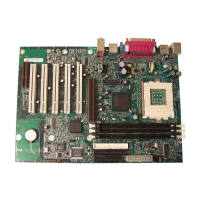
Do you have a question about the Intel D815EEA2 and is the answer not in the manual?
| Brand | Intel |
|---|---|
| Model | D815EEA2 |
| Category | Motherboard |
| Language | English |
Summarizes differences between D815EEA2 and D815EPEA2 boards.
Provides a general overview of the D815EEA2 and D815EPEA2 boards' features.
Details supported processors and cautions for installation and use.
Describes system memory features, installation notes, and limitations.
Describes the chipsets used by the D815EEA2 and D815EPEA2 boards.
Details the features of the standard and optional I/O controllers.
Describes the graphics subsystems used by the D815EEA2 and D815EPEA2 boards.
Details the AC '97 compatible audio subsystem and its connectors.
Describes the network interface controller subsystem features.
Details power management implementation at various levels.
Describes the system memory map, listing address ranges and descriptions.
Details the I/O map, listing address ranges, sizes, and descriptions.
Describes the board's connectors, categorized into groups.
Details power consumption and supply considerations for the boards.
Discusses component temperatures and airflow importance for cooling.
Outlines compliance with safety and EMC regulations.
Introduces the Intel/AMI BIOS, its storage, and update methods.
Explains BIOS resource configuration, including PCI autoconfiguration.
Covers BIOS update utilities and maintenance functions.
Describes available boot options like diskette, hard drive, CD-ROM, and network.
Details BIOS security features like supervisor and user passwords.
Explains how to access and navigate the BIOS Setup program.
Details setting advanced features available through the chipset.
Covers setting passwords and other security-related features.
Details setting power management features like APM and ACPI.
Sets boot features and the sequence for starting the system.
Lists BIOS error messages and their explanations.
Describes POST codes generated by the BIOS for diagnostics.
Lists beep codes and their corresponding error descriptions.
Explains the optional enhanced diagnostics feature and LED codes.
